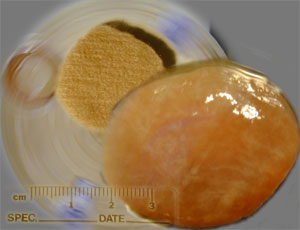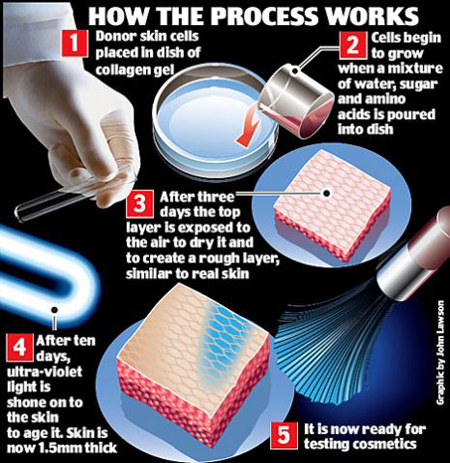Semi-Living Food
Oron Catts and Ionat Zurr
Semi-Living Food: “Disembodied Cuisine”

Another way of treating living systems is by consuming them as food. Throughout history many humans have practiced some kind of division among living entities which are categorized as food or others (such as pets, ornaments, work etc.). These divisions are not always clear, and we must practice some kind of hypocrisy in order to be able to love and respect living things as well as to eat them.
Our latest project titled ‘Disembodied Cuisine’ will be shown in an international biological art exhibition” L’art Biotech’ in Nantes, France March 2003. In the “Disembodied Cuisine” we will attempt to grow frog skeletal muscle over biopolymer for potential food consumption. A biopsy will be taken from an animal which will continue to live and be displayed in the gallery along side the growing “steak”. This installation will culminate in a “feast”. The idea and research into this project began in Harvard in 2000. The first steak we have grown was made out of pre-natal sheep cells (skeletal muscle). We used cells harvested as part of research into tissue engineering techniques in utero. The steak was grown from an animal that was not yet born.
This piece deals with one of the most common zones of interaction between humans and other living systems and will probe the apparent uneasiness people feel when someone ‘messes’ with their food. Here the relationships with the Semi-Living are that of consumption and exploitation however, it is important to note that it is about “victimless” meat consumption. As the cells from the biopsy proliferate the ‘steak’ in vitro continues to grow and expand, while the source, the animal from which the cells were taken, is healing. Potentially this work presents a future in which there will be meat (or protein rich food) for vegetarians and the killing and suffering of animals destined for food consumption will be reduced. Furthermore, ecological and economical problems associated with the food industry (hence, growing grains to feed the animals and keeping them in basic conditions) can be reduced dramatically. However, by making our food a new class of object/being – a Semi-Living – we are risking of making the Semi-Living the new class for exploitation.

Ian Sample, science correspondent of The Guardian
It is the ultimate conundrum for vegetarians who think that meat is murder: a revolution in processed food that will see fresh meat grown from animal cells without a single cow, sheep or pig being killed. Researchers have published details in a biotechnology journal describing a new technique which they hailed as the answer to the world’s food shortage. Lumps of meat would be cultured in laboratory vats rather than carved from livestock reared on a farm.
Scientists have adapted the cutting-edge medical technique of tissue engineering, where individual cells are multiplied into whole tissues, and applied them to food production. “With a single cell, you could theoretically produce the world’s annual meat supply,” said Jason Matheny, an agricultural scientist at the University of Maryland.
The idea of doing away with traditional livestock and growing steaks from scratch dates back at least 70 years. In a horizon-scanning essay from 1932, Winston Churchill said: “Fifty years hence we shall escape the absurdity of growing a whole chicken in order to eat the breast or wing by growing these parts separately under a suitable medium.” Several decades too late, Churchill’s vision finally looks set to become a reality.
Lab-raised steaks will be off the menu for some time though. Scientists believe that while tissue engineering is advanced enough to grow bland, homogeneous meat, tasty and textured cuts will have to wait.
januari 25th, 2010 at 15:55
good article … very informative and beneficial to health … thanks